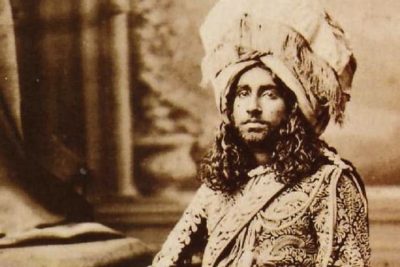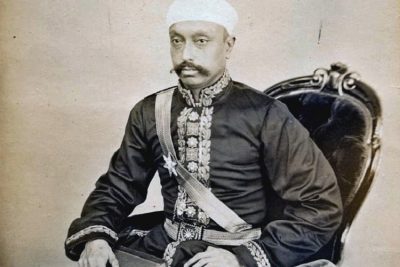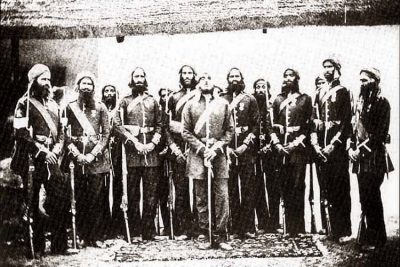Hyderabad State: When Nizams Held Control of an Indian Kingdom During Its Golden Period
Share

Hyderabad state in 1909. (John George Bartholomew / Imperial Gazetteer of India, 1909)
The first thing that strikes us when we think of the Princely state of Hyderabad is wealth and opulence. At the time of his death, the Seventh Nizam was reported to have been the fifth wealthiest person in the world.
However, there is much more to the Asaf Jahi Nizams than mere wealth and opulence. The Asaf Jahis were one of the bravest warriors and excellent swordsmen of their time.
1655: Ancestors of the Nizams of Hyderabad
One thing, though, is very interesting. Did you know that the ancestors of the Nizams of Hyderabad state originally belonged to the Turkic dynasty from around Samarkand in today’s Uzbekistan? Turkic happens to be a subgroup of the Altaic family of languages that are spoken in the western and central parts of Asia.
The grandfather of the First Nizam was a person named Khwaja Abid who hailed from a village called Aliabad, which was close to Samarkand. In those days the region fell under the kingdom of Bukhara. Khwaja Abid was said to be a learned man, who was well-versed in the warfare techniques.
As per records of that era, Khwaja Abid is believed to have visited the Mughal India in 1655 AD. Shortly after that, he is said to have presented himself before Emperor Shah Jahan. Impressed with his skill sets, the emperor granted him favours and a position in the Imperial service.
Thus began the connection between the Mughals and the later Nizams. This association continued till the end of the Mughal rule.
1657: Nawab Khwaja Abid Siddiqi governor of Ajmer
Later in 1657, Khwaja Abid entered into the Imperial service under Aurangzeb, who was at that time the Viceroy of the Deccan. At that time, Aurangzeb was getting ready to wage a war of succession against his brothers and half brothers.
At such a crucial time, Aurangzeb appointed Khwaja Abid to an important position in the Moghul army. After Aurangzeb became the Mughal Emperor, he gave the governorship of Ajmer. Subsequently, he was made the governor of Multan and was also given the title Kilich Khan.
Khwaja Abid, a.k.a Kilich Khan is believed to have died in 1687 during the siege of Golconda, which was under the control of Qutub Shahi kings. At this stage, Kilich Khan had a grandson named Qamaruddin.
After Aurangzeb’s death in 1707 in Ahmednagar, the Mughal dynasty weakened and limped on for another 150 years. In the backdrop of a weak empire and unsettling political environment, rose the Asaf Jahi dynasty. Not willing to be subedars of a bigger kingdom, the Asaf Jahis made Hyderabad their own.
The Nizam of Hyderabad (1724-1948)
Khaja Abid’s grandson Qamaruddin
It all started with Kilich Khan’s grandson Qamaruddin. During Aurangzeb’s time, at the tender age of just 19, Qamaruddin earned his name as a skilful warrior. At that young age, he was even given the title Chin Qilich Khan or Boy Swordsman.
In 1713, Aurangzeb’s grandson emperor Farrukhsiyar gave the title of Nizam-ul-Mulk Fateh Jung to Qamaruddin. He was then appointed as the subedar of six provinces apart from the Faujdar of Karnatak.
Palace intrigues
Qamaruddin was troubled with palace intrigues thanks to the Sayyid brothers, who were powerful generals in the Mughal Empire. The two generals, alarmed by his rise, conspired against Qamaruddin. After the death of the Sayyads, Qamaruddin, by now fed up with palace intrigues, decided to become the viceroy of the Deccan region.
In a decisive battle with the then Subedar of the Deccan Mubrez Khan, Qamarruddin established his supremacy on the region. He immediately started to strengthen Deccan’s administration and finances.
The 1st Nizam: Mir Qamar-ud-din Khan, Asaf Jah I (1724-1748)

A posthumous portrait of Mir Qamaruddin Khan. (Unknown)
Qamarruddin conferred the title of Asaf Jah
Mughal emperor Muhammed Shah then invited Qamarruddin to Delhi. The emperor then extended an olive leaf and gave the title of Asaf Jah on Qamarruddin. Asaf Jah means equal to Asaf. The Grand Vizier of King Solomon’s court was named Asaf.
Asaf Jahi dynasty ruled Hyderabad from 1724
Though viewed as a subject of the Mughal Empire, in reality, Qamaruddin turned out to be an independent ruler. Thus, the Asaf Jahi dynasty ruled Hyderabad from 1724 till September 1948.
According to legend, before leaving Delhi, Qamaruddin is said to have called on a secret Saint and told him of his wish to leave Delhi and go to Deccan. The Saint is said to have blessed him and asked him to take some bread before embarking on the long journey.
Obeying the Saint’s suggestion, Qamaruddin is said to have taken seven pieces of the blessed bread. What happened next is unclear. However, the Saint is said to have indicated that the Asaf Jah dynasty will continue for seven generations.
Nizam-ul-Mulk Asaf Jah I’s rule
Qamaruddin or Nizam-ul-Mulk Asaf Jah I ruled over Hyderabad state for the next 24 years from 1724. Of course, his major achievement was to lay the foundation of Hyderabad, the princely state. As the head of the judicial, executive and defence department, the Nizam I drafted his own laws and set up his own armies. He also created a new flag for Hyderabad state.

The Asafia flag of Hyderabad state. The script on the top reads Al Azmatulillah meaning “All greatness is for God”. The writing in the middle reads “Nizam-ul-Mulk Asif Jah”. The bottom script reads Ya Uthman which translates to “Oh Uthman”. (Yenemus / Wikimedia Commons)
As part of his other initiatives to strengthen the revenues of the Hyderabad state, he split his state into three parts. This system laid the foundation for the growth of the Muslim nobles as jagirdars, zamindars and Deshmukhs. One of the important noble families was the Paigahs. This system remained unchanged until 1950.
During his 24 years of reign, Nizam I, except for the one year war with the Marathas in 1727, the Nizam I hardly waged a war or a battle. Therefore, the Nizam I is known to have laid a firm foundation for an important Muslim state outside West Asia. At that time, the Hyderabad state was estimated to be as large as France.
At the time of his death in 1748, the Nizam was 76 years old. He was buried at the mazaar of Shaikh Burhan-ud-din Gharib Chisti, Khuldabad. Aurangzeb is also said to have been buried close by.
The 2nd, 3rd & 4th rulers(1748-1762) are not counted among the Asafjahi Nizams by the historians although they were recognised by the Mughal emperors in Delhi.
After the death of Mir Qamarruddin, a power struggle ensued between the sons and grandsons of the Nizam I, British, Marathas and the French. During this unsettling period, three members of the Jung family held the kingdom intact for a period of 14 years.
The 2nd Nizam: Mir Nizam Ali Khan, Asaf Jah II (1762-1803)

Portrait of Mir Nizam Ali Khan. (Unknown)
Mir Ali Khan was coroneted as the Nizam II
In 1762, however, the fourth son of the Nizam, Mir Ali Khan was coroneted as the Nizam II. He came to be known as Nizam Ali Khan Asaf Jah II and went on to rule for the next 42 years till 1803. He was 28 years old when he assumed the title.
His reign was very important because he could not only save his dynasty from threats but also improved the state’s administration. He bought peace with the Marathas. He tied up with France and the British with alliances.
Most importantly, he shifted the capital to the more centrally located Hyderabad from Aurangabad in 1763. This shift proved to be crucial for the benefit of the Asaf Jahi rule. Nizam Ali Khan died in 1803. He was 69.
The 3rd Nizam: Mir Akbar Ali Khan, Asaf Jah III (1803-1829)
Mir Akbar Ali Khan Sikander Jah Asaf Jah III
The next Nizam was Mir Akbar Ali Khan Sikander Jah Asaf Jah III. He ruled from 1803 to 1829. Sikandar Jah can be credited for the new era in the progress of Hyderabad. The city expanded to the north in 1806. The expanded city was named Secunderabad after Sikander Jah. Till then, Secunderabad was known as Lashkar, meaning cantonment. After his death in May 1829, his eldest son named Nawab Farkhunda Ali Khan was coroneted.
The 4th Nizam: Mir Farqunda Ali Khan, Asaf Jah IV (1829-1857)
Mir Farkhunda Ali Khan Nasirud-Daula Asaf Jah IV
Mir Farkhunda Ali Khan Nasirud-Daula Asaf Jah IV ruled from 1829 till 1857. The Hyderabad state was in deep financial turmoil at the time of his coronation. The first act Nizam IV did was to tackle the mounting debt. For this, he ceded several border districts including Berar to the British.
Financial turmoil
To further overcome the financial turmoil, a new model of just revenue administration was introduced. He removed the systems of jagirs, zamindari and deshmukh and introduced the concept of taluqdar.
He divided Hyderabad state into 16 districts. Each district had a taluqdar. This system brought in improved transparency in administration. In this way, Nizam IV safely steered the Hyderabad state through a critical phase. During his reign, Hyderabad prospered with schools, business centres and bridges.
Nizam banned the practice of Sati
One year before his death in May 1857, the Nizam banned the practice of Sati in the kingdom. Thus, Hyderabad became the first princely state in India to do so.
The 5th Nizam: Mir Tahniyath Ali Khan, Asaf Jah V (1857-1869)
Mir Tahniyath Khan Afzal-ud-Daula Asaf Jah V
Sikandar Jah’s son, Mir Tahniyath Khan Afzal-ud-Daula Asaf Jah V, took over the reins from him in 1857 and ruled for just 12 years till 1869. Afzal-ul-Daula can be credited for giving land for the Bombay- Madras railway line, building the Afzalgunj Bridge, mosque and bazaar.
He died at the young age of 42. He was succeeded by his son Nawab Mir Mahbub Ali Khan. The VI Nizam was just about three years old at that time.
The 6th Nizam: Mir Mahbub Ali Khan, Asaf Jah VI (1869-1911)
Mir Mahbub Ali Khan Bahadur Asaf Jah VI

Nizam Mahboob Ali Khan. (Royal Collection Trust)
He became Mir Mahboob Ali Khan Bahadur Asaf Jah VI in 1869 and went on to rule for the next 42 years till 1911.
Till he attained the age of 17 in 1885, the youngest Asaf Jahi ruler’s co-regents Nawab Rasheeduddin Khan, Mir Turab Ali Khan, Sir Salar Jung I and Shams-ul-Umara III oversaw the administration.
Rapid development witnessed
After he assumed his sovereign rights, Nizam VI made rapid development in the fields of railways, revenue system and establishment of silk and cotton mills. Other fields that came under his spotlight include education, judiciary, police, excise, forest and health.
It was during this period, the Nizam’s brother-in-law (Viqar-ul-Umara) is said to have constructed the Falaknuma Palace and gifted it to the Nizam. However, sadly, during his short stay at the palace, the Nizam fell, suffered a paralytic stroke and died at the age of 46.

Falaknuma Palace, 1900. (Collection of Horatio Kitchener)
The 7th Nizam: Mir Osman Ali Khan, Asaf Jah VII (1911-1948)
Mir Osman Ali Khan Bahadur Asaf Jah VII
On September 12, 1911, the world-famous Mir Osman Ali Khan Bahadur Asaf Jah VII got coroneted as Nizam VII. He was born in 1886. His first act as the Nizam was to abolish capital punishment for civilians. During World War I, he extended military, financial and material support to the British. He established the Osmania University in Hyderabad in 1917.

Osmania University students wearing Deccani sherwani and caps, circa 1939. (Cecil Beaton / Imperial War Museums)
He then separated the executive from the judiciary in 1921. In the rest of India, this was done in 1974. Several public buildings that are functional today were built by him.
Generously donated money to educational institutions
He generously donated money to educational institutions like Aligarh Muslim University, Benaras Hindu University, and Santiniketan. He then gifted away 14,000 acres of land for the Bhoodan Movement in Pochampally near Hyderabad city.
Last Nizam refused to merge Hyderabad state with India
In 1947, India became an independent nation and asked all the princely states to merge with the Union of India. However, the last Nizam Mir Osman Ali Khan refused to merge Hyderabad state with India. He desired to retain Hyderabad as an independent sovereignty.
However, India’s first Home Minister Sardar Vallabhbhai Patel, in no uncertain terms, told the Nizam that India will not tolerate this. After several negotiations, the Indian government signed a standstill agreement with the Nizam in November 1947. India hoped the Nizam will set up a representative government in Hyderabad which will then help in the merger process.
Three crucial developments
But, Mir Osman Ali Khan had different views. With a view to negotiating with the Indian government on his behalf, he engaged British lawyer Sir Walter Monckton. He wanted to buy time through negotiations in order to build up his armed forces to clash with India. In this connection, the Nizam was believed to have been in talks with the Portuguese administration in Goa and also Pakistan.
In June 1948, the last Governor General of India Lord Mountbatten proposed a deal called the Heads of Agreement. As per the deal, Hyderabad was to get the status of an autonomous dominion nation under India. Though India agreed to sign the deal, the Nizam is said to have refused it. On August 27, 1947, the Nizam actually declared he wanted complete independence. Or else, he wanted a dominion status under the British Commonwealth of Nations.
The Nizam is said to have issued a firman that Hyderabad would remain independent. It would not join the Constituent Assembly. Soon after the declaration, Kasim Razvi unfurled the Asafia Flag and exhorted Hyderabadis to defend the state to the last.

Kasim Razvi, the leader of Razakars a private militia that supported the rule of Nizam Osman Ali Khan. (Unknown)
In connection with the issue of joining the Indian Union, Mir Osman Ali Khan is believed to have rejected the advice of his constitutional advisors like Walter Monckton. Walter was a close friend of Lord Louis Mountbatten, who wanted to ensure that Hyderabad held a high status in the Union of India.
Meantime, three crucial developments took place in Hyderabad state. First, Muslim communal organization named Ittihad ul Muslimeen and its paramilitary wing, the Razakars grew by leaps and bounds.

The Razakars of Hyderabad state undergoing military training. (Unknown)
At the same time, The Hyderabad State Congress launched a mass struggle against the Nizam on August 7, 1947. Finally, the peaceful agitation of the Congress against the Nizam turned violent. Meantime, however, a parallel struggle took place. The communist-led peasant movement turned into an armed struggle in the Hyderabad state from 1946 onwards.
This chaos and the unclear negotiations failed to go down well with the Indian Government.
While referring to the idea of an independent Hyderabad state, Sardar Patel reportedly said an ulcer in the heart of India should be surgically removed. This was when he decided to annex Hyderabad. One person who also played a key role in the annexation of Hyderabad was Rao Bahadur Vappala Pangunni Menon, CSI, CIE. This Indian civil servant was simply known as VP Menon.
Operation Polo launched
With no hope of solving the Hyderabad problem until June 1948, an annoyed Patel launched Operation Polo on September 13, 1948. The operation, which was named after the 17 polo fields in the then Hyderabad state, was also referred to as “Operation Caterpillar”. The operation was also referred to as Police Action.
Major General Chaudhuri led 36,000 Indian troops into Hyderabad state in the early hours of September 13 of 1948. Operation Polo was a two-pronged advance. The main force marched along the Sholapur-Hyderabad road, while a smaller diversion marched along the Bezwada-Hyderabad road. Unable to counter the might of the Indian army, the Nizam’s Army surrendered on September 17.
Records show that roughly 32 Indian soldiers were killed and 97 were injured. Meanwhile, 1373 Razakars and 50,000 civilians were killed with some reports suggesting much higher in the five-day “Operation Polo”. Meanwhile, as the Indian government was apprehensive on how the rest of India would react, a state of Emergency was declared. At the time of the formal surrender of Hyderabad, the state had a population of about 1.60 crores.
In November 1948, the last Nizam formally acceded to the Indian Union, thus, bringing the Asaf Jahi dynasty’s rule in Hyderabad to an end after 225 years.
Enjoyed this article? Also, check out “Bibi ka Maqbara: The Taj of Deccan, Which Like the Original, Tells the Tale of Eternal Love“.
Fact Analysis:
STSTW Media strives to deliver accurate information through careful research. However, things can go wrong. If you find the above article inaccurate or biased, please let us know at [email protected]














